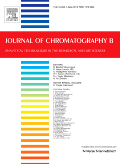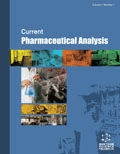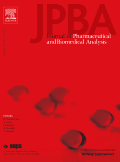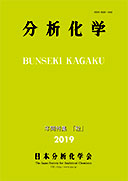
Separation Science Plus
Scope & Guideline
Elevating the standards of separation science research.
Introduction
Aims and Scopes
- Analytical Method Development and Validation:
The journal emphasizes the development and validation of new analytical methods, particularly those utilizing high-performance liquid chromatography (HPLC) and mass spectrometry (MS) techniques, aimed at improving accuracy and reliability in various applications. - Quality by Design (QbD) Approaches:
A significant focus is placed on the Quality by Design methodology, which integrates systematic approaches to method development, ensuring robust and reproducible analytical results. - Application of Green Chemistry Principles:
The journal promotes research that incorporates green chemistry principles into analytical methods, aiming to reduce environmental impact and enhance sustainability in separation processes. - Pharmacokinetics and Drug Analysis:
Many studies featured in the journal involve pharmacokinetic evaluations and drug analysis, particularly using liquid chromatography-tandem mass spectrometry (LC-MS/MS) for bioanalytical applications. - Emerging Techniques in Separation Science:
The journal regularly publishes findings on innovative separation techniques, including microextraction methods, novel stationary phases, and advanced chromatographic techniques, reflecting the latest advancements in the field.
Trending and Emerging
- Advanced Analytical Techniques:
There is a clear trend towards the integration of advanced analytical techniques, such as ultra-high-performance liquid chromatography (UHPLC) and liquid chromatography-mass spectrometry (LC-MS), which allow for more sensitive and efficient analyses. - Green Analytical Chemistry:
The incorporation of green chemistry principles into analytical methods is gaining momentum, highlighting researchers' commitment to sustainability and environmental protection in separation science. - Microextraction Techniques:
Innovative microextraction techniques, such as solid-phase microextraction (SPME) and dispersive liquid-liquid microextraction (DLLME), are increasingly featured, reflecting their importance in improving sample preparation and analysis. - Pharmaceutical Impurity Profiling:
There is a rising interest in the analysis and profiling of pharmaceutical impurities, driven by regulatory demands and the need for improved quality control in drug development. - Bioanalytical Applications:
The trend towards bioanalytical applications, particularly in pharmacokinetics and drug metabolism studies, is becoming increasingly prominent, addressing the need for comprehensive drug analysis in biological matrices.
Declining or Waning
- Traditional Chromatography Techniques:
There is a noticeable decrease in research focused on traditional chromatographic methods without advanced modifications, as researchers are increasingly favoring innovative techniques that enhance efficiency and sustainability. - Basic Qualitative Analysis:
The emphasis on basic qualitative analysis has waned, with a shift towards more quantitative and detailed analytical methods that provide comprehensive insights into sample composition. - Single-Component Analysis:
Research centered around the analysis of single compounds is becoming less frequent, as there is a growing trend towards multi-component analysis and the simultaneous quantification of multiple analytes. - Non-HPLC Methods:
The focus on non-HPLC methods appears to be diminishing as the advantages of HPLC and related techniques continue to dominate the field, leading to fewer publications on other separation methodologies.
Similar Journals

LCGC North America
Shaping the Landscape of Chromatography and Analytical TechniquesLCGC North America is a pivotal resource in the field of Analytical Chemistry, published by MJH Life Sciences. Since its inception in 1999, the journal has strived to bridge the gap between scientific research and practical applications, catering to a diverse audience that includes researchers, professionals, and students interested in chromatography and related analytical practices. Although currently categorized in the Q4 quartile of Analytical Chemistry, with a Scopus rank of #137 out of 156, LCGC North America is dedicated to delivering insightful articles that foster discussion and innovation within the analytical chemistry community. With a commitment to quality content, the journal covers a broad spectrum of topics, ensuring that readers remain informed about the latest developments and trends in the field. Despite its non-open access model, readers can access its valuable resources through institutional subscriptions and various library networks, making it a vital asset for those engaged in cutting-edge research and practice. Located in Cranbury, NJ, United States, LCGC North America continues to contribute significantly to the advancement of analytical methodologies and technologies.

Chinese Journal of Chromatography
Transforming Challenges into Solutions through ChromatographyChinese Journal of Chromatography, published by SCIENCE PRESS, is a dedicated platform for disseminating pioneering research in the fields of Analytical Chemistry, Biochemistry, and Organic Chemistry. Established in 1997, this esteemed journal offers invaluable insights into chromatographic techniques and their applications, showcasing studies that contribute to the advancement of chemical engineering and electrochemistry. Although it currently holds a Q4 ranking in several categories, the journal aims to foster growth and knowledge among researchers, professionals, and students alike. With a continuous publication window extending until 2024, the Chinese Journal of Chromatography invites submissions that not only enhance scientific understanding but also address real-world challenges through innovative chromatographic solutions. Researchers looking for a collaborative community will find this journal a vital resource in their ongoing academic endeavors.

JOURNAL OF CHROMATOGRAPHY B-ANALYTICAL TECHNOLOGIES IN THE BIOMEDICAL AND LIFE SCIENCES
Transforming Biomedical Challenges through ChromatographyJOURNAL OF CHROMATOGRAPHY B-ANALYTICAL TECHNOLOGIES IN THE BIOMEDICAL AND LIFE SCIENCES, published by Elsevier, stands as a critical resource in the fields of analytical chemistry, biochemistry, and life sciences. With an impressive convergence of research spanning from 2002 to 2024, this journal delivers high-quality, peer-reviewed articles that advance the methodologies and practices related to chromatographic techniques and their applications in biomedical research. The journal enjoys a reputable standing in the academic community, reflected in its 2023 Scopus rankings—ranked in the 65th and 55th percentiles in Analytical Chemistry and Clinical Biochemistry, respectively. Although it does not offer open access, it provides a vital platform for exchanging innovative ideas and findings, guiding professionals and scholars in addressing the complexities of contemporary biomedical challenges. The journal’s focus on interdisciplinary research positions it as an essential tool for researchers, professionals, and students eager to enhance their knowledge and contribute to advancements in this dynamic field.

Analytical and Bioanalytical Chemistry Research
Bridging Disciplines in Analytical and Bioanalytical Chemistry.Analytical and Bioanalytical Chemistry Research is an esteemed open-access journal published by the Iranian Chemical Society, dedicated to the advancement of knowledge in the fields of analytical chemistry, biochemistry, and spectroscopy. Since its inception in 2014, this journal has provided a platform for researchers, professionals, and students to publish and access high-quality research articles that contribute to the understanding of chemical analysis and bioanalytical methods. With an ISSN of 2383-093X and an open-access model that promotes global dissemination of findings, it ensures that innovative research reaches a broad audience. The journal has consolidated its presence in the scientific community, currently ranked in quartile Q4 for analytical chemistry, biochemistry, and spectroscopy as of 2023. Its Scopus rankings, including a percentile of 34th in Analytical Chemistry, reflect its commitment to quality research and scholarly contribution. Situated in Tehran, Iran, the journal serves as a vital resource for academic discourse, offering insights into emerging trends and methodologies in analytical and bioanalytical chemistry.

Current Pharmaceutical Analysis
Catalyzing Discoveries in Biochemistry and Molecular MedicineCurrent Pharmaceutical Analysis, published by Bentham Science Publishers Ltd, is a vital resource for professionals and researchers in the fields of Pharmaceutical Science, Biochemistry, and Molecular Medicine. Established in 2006, this peer-reviewed journal aims to provide a platform for the latest advancements and analytical methodologies in pharmaceutical research and drug development. Over the years, it has garnered attention for its rigorous scrutiny and contributions to the landscape of pharmacology, evidenced by its quartile placements in various categories, most notably Q3 in Pharmaceutical Science. Despite its current rankings placing it in the lower quartile in several disciplines, the journal remains an essential venue for both emerging and established researchers seeking to disseminate their findings. With the widespread accessibility of its articles, researchers, professionals, and students can engage with cutting-edge studies to foster innovation in pharmaceutical analysis. For access to the latest research contributions, readers can explore the digital archive and stay updated on pivotal discussions shaping the future of the pharmaceutical sciences.

ANALYTICAL AND BIOANALYTICAL CHEMISTRY
Fostering Global Collaboration in Analytical ChemistryANALYTICAL AND BIOANALYTICAL CHEMISTRY, published by SPRINGER HEIDELBERG, is a leading international journal that serves as a vital platform for innovative research in the fields of analytical and bioanalytical chemistry. With an impressive impact factor and ranking in the Q2 category for both Analytical Chemistry and Biochemistry, the journal highlights key advancements and methodologies that drive the discipline forward. Established in 1996 and continuing vigorously into 2024, it has gained significant recognition with Scopus rankings placing it in the 83rd and 78th percentiles within its categories, underscoring its impact and relevance. The journal's commitment to open access facilitates widespread dissemination of critical scientific knowledge, making it an essential resource for researchers, professionals, and students dedicated to exploring the complexities of chemical analysis. With its base in Heidelberg, Germany, ANALYTICAL AND BIOANALYTICAL CHEMISTRY continues to inspire and influence the global research community.

Journal of Pharmaceutical and Biomedical Analysis
Exploring the intersection of analytical chemistry and biomedicine.The Journal of Pharmaceutical and Biomedical Analysis, published by ELSEVIER and available in print and online formats, stands as a pivotal source of knowledge in the realms of Analytical Chemistry, Clinical Biochemistry, Drug Discovery, and Pharmaceutical Science. With an ISSN of 0731-7085 and an e-ISSN of 1873-264X, this journal is dedicated to publishing high-quality research that advances the understanding and development of analytical techniques in pharmaceuticals and biomedicine. The journal has earned a solid reputation, reflected in its Q2 category rankings across five distinct fields for 2023, and boasts impressive Scopus rankings, signaling its robust impact within the academic community. The Journal of Pharmaceutical and Biomedical Analysis serves as an essential resource for researchers, professionals, and students alike, providing actionable insights and fostering innovation that can directly influence future advancements in drug development and biomedical applications.

BUNSEKI KAGAKU
Cultivating Knowledge in Analytical Chemistry Since 1952BUNSEKI KAGAKU, published by the Japan Society Analytical Chemistry, is a reputable journal dedicated to the field of analytical chemistry. With an ISSN of 0525-1931, this journal has been a crucial outlet for scholarly communication since its inception in 1952, converging its publication years from 1954 to 1957 and from 1959 to 2024. Although it holds a Q4 category ranking in the most recent 2023 quartiles of analytical chemistry and ranks 153/156 in Scopus, it continues to serve as a platform for quality research, fostering advancements in the field. BUNSEKI KAGAKU is based in Tokyo, Japan, and emphasizes the critical importance of analytical techniques in scientific inquiry. With a commitment to professionalism and rigor, the journal provides a vital resource for researchers, students, and professionals seeking to explore innovative methodologies and contribute to the ongoing dialogue in analytical chemistry.

JPC-JOURNAL OF PLANAR CHROMATOGRAPHY-MODERN TLC
Pioneering Techniques in Planar Chromatography.JPC-JOURNAL OF PLANAR CHROMATOGRAPHY-MODERN TLC, published by Springer Heidelberg, is a pivotal resource in the fields of Analytical Chemistry, Biochemistry, and Clinical Biochemistry. With an ISSN of 0933-4173 and an E-ISSN of 1789-0993, this journal serves as an essential platform for the dissemination of innovative research on planar chromatography techniques, specifically modern thin-layer chromatography (TLC). With its upcoming coverage extending to 2024 and a third quartile ranking (Q3) across major scientific categories in 2023, it addresses the critical advancements and applications in analytical methods. Although it does not offer open access, the journal's rigorous peer-review process ensures high-quality findings that contribute to the progression of these vital scientific disciplines. The journal is located in Heidelberg, Germany, and continues to be a beacon for researchers, professionals, and students who seek to enhance their knowledge and practice in chromatographic techniques.

CHINESE JOURNAL OF ANALYTICAL CHEMISTRY
Fostering Scientific Inquiry in Analytical ChemistryCHINESE JOURNAL OF ANALYTICAL CHEMISTRY, published by SCIENCE PRESS in China, stands as a prominent platform in the field of analytical chemistry since its inception in 1989. With its ISSN 0253-3820 and E-ISSN 1872-2040, the journal maintains a vital role in disseminating empirical research and innovative methodologies, contributing to the advancement of analytical techniques and their applications. The 2023 Scopus ranking positions the journal in the third quartile (Q3) within its category, reflecting a respectable standing among its peers. Researchers, professionals, and students alike engage with a broad range of topics, from instrumental analysis to environmental monitoring, each aiming to foster further scientific inquiry. Although it does not currently offer Open Access, the journal's rich repository of knowledge continues to be an essential resource for those in the analytical chemistry community, with an enduring commitment to scientific excellence and collaboration.